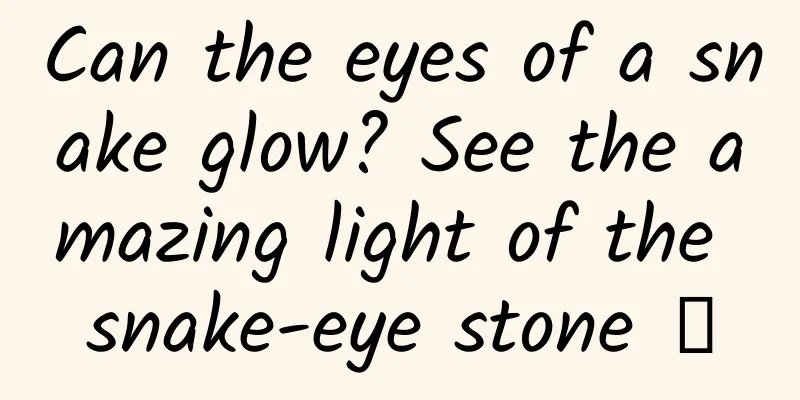Can the eyes of a snake glow? See the amazing light of the snake-eye stone →

|
On a dark and windy night, snakes danced wildly on the small hills, and a faint blue light flickered in the clouds and fog. The terrifying scene and mysterious light sparked all kinds of speculations! Is there a treasure hidden in the mountains? Or is it a murderous intention in the dark night? It is said that on a hill in ancient India, when night falls, people will find many poisonous snakes entwined around a large stone. And this large stone can actually emit a faint blue light. This strange phenomenon aroused the curiosity of local people, and this stone is also called snake eye stone. The "snake eye stone" that attracts snakes to gather (the picture comes from the Internet, please delete if it infringes) After research, the truth finally came to light... It turned out that there was a luminous mineral on the stone - fluorite. The light emitted by fluorite attracted flying insects with phototaxis, frogs came to catch the insects, and poisonous snakes followed closely, resulting in the phenomenon of poisonous snakes entrenching. Similar incidents have also been reported in my country. Green transparent fluorite specimens in the collection Fluorite is a mineral produced all over the world. Its main component is calcium fluoride. Its crystals are usually octahedral or cubical. It is rich in colors and very beautiful. Therefore, it was often used to make decorations in ancient times. It was given the word "firefly" because of its luminous properties. Octahedral single crystal specimen of fluorite in the collection Due to its large output and low hardness, fluorite is not a gemstone. Since the industrial age, it has been often used as a flux in smelting metals. Its mineral name "Fluorite" is also related to this. It comes from the Latin word "Fluere", which means "flowing". As a representative of luminous minerals, it prompted the birth of the term "Fluorescence". Fluorite crystal structure diagram (picture from the Internet, please delete if infringement) In fact, not all fluorites can emit light, and there are more than one type of mineral that can emit light. Common minerals such as calcite and gypsum, as well as precious minerals such as ruby and spinel, all have the potential to emit light. The reason why we say potential is that they need to meet certain conditions to emit light. Luminescence phenomenon of calcite specimens in museum collections Luminescence of ruby crystals in museum collections Energy from the outside world is the external condition for these minerals to glow. Self-luminescence does not exist. After all, "a good cook cannot cook without rice". Where do they get the energy they need? Collecting the spiritual energy of heaven and earth, receiving the essence of the sun and the moon... Of course, it is not so mysterious, but the ultraviolet light and heat energy in sunlight can indeed make minerals glow. Some minerals even have "masochistic" properties, and can obtain the energy to glow by hitting with blunt objects, rubbing on the ground, etc. A variety of luminescent minerals in the museum's collection under long-wave ultraviolet light This is not to encourage you to pick up a hammer and walk towards the trembling mineral specimens. To glow, minerals must have some unique internal conditions. First, they are highly tolerant. With their unique crystal structure, they are very tolerant of impurities, such as rare earth elements. Secondly, they are cheerful and lively. The lively impurities make up their lively character, so they will glow when stimulated by energy. 17 rare earth elements (pictures from the Internet, please delete if infringed) The duration of mineral luminescence varies. Some stop luminescence immediately after the energy is interrupted, which is called the fluorescence effect, while others can last for a period of time, which is called the phosphorescence effect. Some of these minerals have a particularly long duration of luminescence and are very rare. If they are rounded, they become night-shining pearls with high ornamental value. Even for fluorescent minerals, if many types are gathered in one room, the visual effect when they glow is also great. Night Pearls in the Museum's Collection Part of the Luminous Minerals Exhibition Hall |
>>: Cell Breakthrough: This newly developed diet produces immediate results in 3 weeks!
Recommend
@Teachers, students and parents: 42 summer safety tips, must read!
July has begun Students from all over the country...
What do WeChat mini programs do? What can WeChat mini programs be used for?
Q: What does the WeChat Mini Program do? What can...
Ankang SEO Training: How to optimize the entire site to achieve good results?
How to better optimize the entire site is a quest...
Google's fourth-generation TPU performance test is here! This year, it will provide services to Google Cloud users
This article is reprinted with permission from AI...
4000 words of Xiaohongshu video notes operation tips
2021 will still be a year of rapid development fo...
9 Strategies for Optimizing E-Commerce Product Details Pages
Consider the following scenario: Let’s say you ar...
Baidu Information Flow 11.11 Marketing Manual!
How is the traffic trend of Baidu Information Flo...
4000+ useful information! A comprehensive B-side design guide: fonts
In B-side design, fonts are often the most freque...
Metaverse Community Platform UHive Product Analysis
Metaverse is a term that has suddenly emerged rec...
As the transformation towards entertainment accelerates, why doesn’t NetQin take off its helmet?
After nearly 10 years of development, NetQin'...
Beware! These three mushrooms are extremely toxic
Whenever a netizen asks the question "Is thi...
PPT animation all-rounder, I never thought that PPT is actually an animation software
: : : : : : : : : : : : : : :...
iOS 10 will usher in HomeKit independent application. Will Apple still be the smart home disruptor?
In 2014, Google acquired Nest Labs for $3.2 billi...
There is a kind of relationship on WeChat called the silent "zombie relationship". How to promote it through WeChat marketing?
WeChat promotion, WeChat marketing, how to promote...
How about Mingdao Team’s “Bidding Customer Service Talk and Transaction System”? Is customer service skills useful for newcomers in bidding operations?
First of all, I support your question. Then, I ex...









